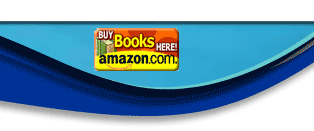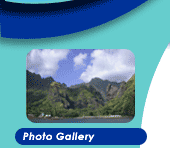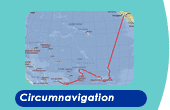February
5, 2001
Cartagena,
Colombia
Force 10 – a Night of Sheer Terror.
By Gunter Hofmann  
We took delivery of our Catana 431 called “Pacific Bliss” in Canet,
France in October 2000 and sailed her from there to Spain, Gibraltar,
Tangier, the Canary Islands, the Cape Verde Islands and across the Atlantic.
Our passage through the Med, with the wind and waves on our nose, was
difficult, but our Atlantic crossing was very nice with good trade winds
allowing us to fly a spinnaker day and night. After a landfall in Santa
Lucia last December, we resumed our voyage in January on through the
Windward Islands, to Bequia and on to Grenada, many times experiencing
a F7 to F8.
From Grenada, we sailed to Islas los Roques, north of Venezuela. We
had some adventures there, but that is another story. From these islands,
we sailed to Bonaire for reprovisioning and then set sails to Cartagena,
Columbia, a trip of about 600 nautical miles, as an intermediate stopover
on our way to the San Blas Islands and Panama. We took a wide swing
around the peninsula of Guajira, a lawless piece of land between Venezuela
and Columbia, where much of the drug trafficking is happening. We stayed
about 100 nautical miles off this coast.
Heading west from Bonaire on Jan.29th was uneventful in
F4-6 winds with westerly swells. Under a double reefed main only we
enjoyed the ride. On Jan 30th, the wind started to gust up
to F 7. On Jan 31st around 1700 we put in the third
reef; the waves were building up, although the wind was a consistent
F6. We were ahead of our schedule and did not want to arrive at
Cartagena before dawn. With the third reef, our speed dropped
from 8-10 knots to about 6-8 knots. We enjoyed an early dinner
and anticipated settling in for a nice night.
During the early evening hours, the sea conditions worsened and large
rollers began to come towards us. The wind started to go up to F7 and
then to F8. We were at this time about 22 miles off the Columbian coast.
Starting around 2100 the wind increased to F8 to F9. The boat speed
was about 9-13 knots and we were running before the waves and the wind.
Our Raytheon autopilot on our hydraulic steering system had worked well
so far. However, occasionally, the autopilot was too slow to react to
the waves and caused the boat to come close to broaching conditions.
Around 2300 all hell broke loose. The wind became a consistent F9 with
lengthy gusts of F10, true winds of 50 + knots. These gusts came
with a frightening howl and ripped the bimini shades loose. They
flopped wildly until I ripped them off completely to avoid injuries.
The seat cushions came alive and flopped up and down.
We had the dagger boards all the way up, because we found earlier that
the boat floated easier over the rollers, especially those rollers that
came from a more sideways direction. The following seas began to mount
to frightening height with breaking crests. One wave broke over the
starboard dagger board top, which is almost 6 feet above the deck. That
wave pushed also so hard against the starboard side of the boat that
a jet of water came through the seals on the normally dry master cabin
window. The sea came boiling up to the level of the cockpit floor, though
we never saw large amounts if water entering the cockpit.
The boat felt uncontrollable when the F10 gusts accelerated the boat
to about 25 knots (triple reefed!). At this time we became very concerned
about our situation because we did not know what would lie ahead. The
boat got hit so hard the whole structure shuddered at high frequency
and the creaking, bombing and banging caused us to pray for it to hold
together. I tried to slow down the boat by trailing a warp made from
3 black docking lines, which decreased the boat speed by about 2-3 knots. Once,
the autopilot reacted too slowly and we broached and went into a jibe
that led to a back winded sail and a boat drifting without control.
I pulled in the warp to clear the propellers and got out of irons with
the two engines running. For a moment we considered leaving the boat
in irons, but I was afraid that waves would break over the dinghy and
over the cockpit.
In a quick assessment of the situation, with a mouth dry from the adrenalin
rush, I remembered the advice I obtained in Canet from Jean Pierre,
the founder of Catana, discussing heavy weather techniques: “Run with
the wind and the waves as long as you can to lower your apparent wind.”
We felt that we were not in danger of capsizing and that we had several
hundred miles of seaway to allow us to run for a long time. So that
decision is what we settled in for the rest of this very long night.
We also learned to work with the autopilot: In order to avoid an unstable
situation, we took over manually quickly every time the compass showed
a 30-degree swing from our set course.
So for the remainder of the night we worked the boat and kept her running
with the wind and waves. We kept the engines running on idle in the
case we needed to get out of irons quickly again.
Around 0200 the wind eased off to F8, for us a relief, though the waves
built up to impressive heights, coming from changing directions in a
confused sea.
Around 0500 we need to change course to a beam reach to go into Cartagena
which required us to jibe in F8. This maneuver went amazingly smooth,
thanks to the triangular main sheet system without a traveler. We were
apprehensive about going into a beam reach with the monster waves continuing
to slam our port side. Pacific Bliss, however, floated like a
cork over the sideways combers. We kept the dagger boards up to
avoid lateral resistance.
As the light of the day appeared, we were thankful that the worst of
the storm had occurred at night in total darkness, sparing us the traumatic
images of the wild rollers coming at us.
A few hours later we entered quieter waters and the harbor of Cartagena
to dock at the Club Nautico.
Pacific Bliss held up beautifully under these conditions without any
structural damage (at least I could not see any cracks, etc.)
As an aside, at the marina we met Francoise and Bernard, owners of
a Catana 471, Adelaide II, which is two years old. Bernard told
us that he went through similar, though somewhat lighter, conditions
near that same area, but with all the sails down. We celebrated with
them our survival and arrival with a bottle of “Catana Champagne” and
two bottles of white Bordeaux, which had traveled with us all the way
from Canet and were still quite enjoyable. When I asked his opinion
of the best way to transport wine and Champagne over long distances
in a shaking boat, he replied, “horizontally, lying down, ”comme une
femme”. Great to know.
For explanation
of Beaufort Force and Table, click here
|











